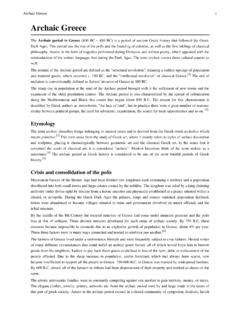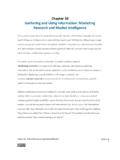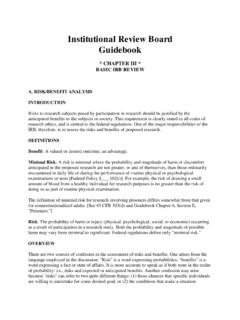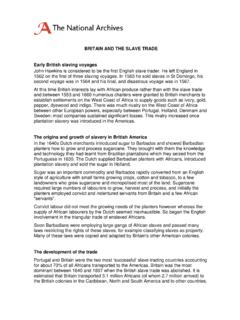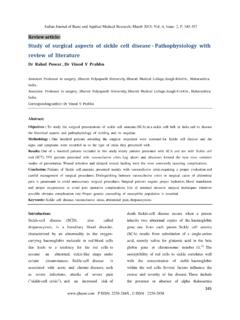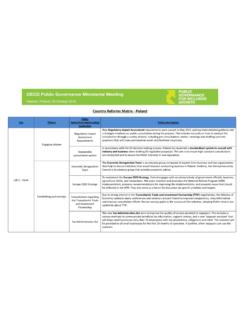Transcription of A Brief Overview of the Trans-Atlantic Slave Trade David Eltis
1 A Brief Overview of the Trans-Atlantic Slave Trade David Eltis Introduction The Trans-Atlantic Slave Trade was the largest long-distance coerced movement of people in history and, prior to the mid-nineteenth century, formed the major demographic well-spring for the re-peopling of the Americas following the collapse of the Amerindian population. Cumulatively, as late as 1820, nearly four Africans had crossed the atlantic for every European, and, given the differences in the sex ratios between European and African migrant streams, about four out of every five females that traversed the atlantic were from Africa. From the late fifteenth century, the atlantic Ocean, once a formidable barrier that prevented regular interaction between those peoples inhabiting the four continents it touched, became a commercial highway that integrated the histories of Africa, Europe, and the Americas for the first time. As the above figures suggest, slavery and the Slave Trade were the linchpins of this process.
2 With the decline of the Amerindian population, labor from Africa formed the basis of the exploitation of the gold and agricultural resources of the export sectors of the Americas, with sugar plantations absorbing well over two thirds of slaves carried across the atlantic by the major European and Euro-American powers. For several centuries slaves were the most important reason for contact between Europeans and Africans. What can explain this extraordinary migration, organized initially on a continent where the institution of slavery had declined or totally disappeared in the centuries prior to Columbian contact, and where, even when it had existed, slavery had never been confined to one group of people? To pose the question differently, why slavery, and why were the slaves carried across the atlantic exclusively African? The short answer to the first of these two questions is that European expansion to the Americas was to mainly tropical and semi-tropical areas. Several products that were either unknown to Europeans (like tobacco), or occupied a luxury niche in pre-expansion European tastes (like gold or sugar), now fell within the capacity of Europeans to produce more abundantly.
3 But while Europeans could control the production of such exotic goods, it became apparent in the first two centuries after Columbian contact that they chose not to supply the labor that would make such output possible. Free European migrants and indentured servants never traveled across the atlantic in sufficient numbers to meet the labor needs of expanding plantations. Convicts and prisoners the only Europeans who were ever forced to migrate were much fewer in numbers again. Slavery or some form of coerced labor was the only possible option if European consumers were to gain access to more tropical produce and precious metals. Source URL: Saylor URL: # Attributed to: David Eltis Page 1 of 11. The Enslavement of Africans But why were the slaves always African? One possible answer draws on the different values of societies around the atlantic and, more particularly, the way groups of people involved in creating a Trans-Atlantic community saw themselves in relation to others in short, how they defined their identity.
4 Ocean-going technology brought Europeans into large-scale face-to-face contact with peoples who were culturally and physically more different from themselves than any others with whom they had interacted in the previous millennium. In neither Africa nor Asia could Europeans initially threaten territorial control, with the single and limited exception of western Angola. African capacity to resist Europeans ensured that sugar plantations were established in the Americas rather than in Africa. But if Africans, aided by tropical pathogens, were able to resist the potential invaders, some Africans were prepared to sell slaves to Europeans for use in the Americas. As this suggests, European domination of Amerindians was complete. Indeed, from the European perspective it was much too complete. The epidemiological impact of the Old World destroyed not only native American societies, but also a potential labor supply. Every society in history before 1900 provided at least an unthinking answer to the question of which groups are to be considered eligible for enslavement, and normally they did not recruit heavily from their own community.
5 A revolution in ocean-going technology gave Europeans the ability to get continuous access to remote peoples and move them against their will over very long distances. Strikingly, it was much cheaper to obtain slaves in Europe than to send a vessel to an epidemiologically coast in Africa without proper harbors and remote from European political, financial, and military power. That this option was never seriously considered suggests a European inability to enslave other Europeans. Except for a few social deviants, neither Africans nor Europeans would enslave members of their own societies, but in the early modern period, Africans had a somewhat narrower conception of who was eligible for enslavement than had Europeans. It was this difference in definitions of eligibility for enslavement which explains the dramatic rise of the Trans-Atlantic Slave Trade . Slavery, which had disappeared from northwest Europe long before this point, exploded into a far greater significance and intensity than it had possessed at any point in human history.
6 The major cause was a dissonance in African and European ideas of eligibility for enslavement at the root of which lies culture or societal norms, not easily tied to economics. Without this dissonance, there would have been no African slavery in the Americas. The Slave Trade was thus a product of differing constructions of social identity and the ocean-going technology that brought atlantic societies into sudden contact with each other. The Trans-Atlantic Slave Trade therefore grew from a strong demand for labor in the Americas, driven by consumers of plantation produce and precious metals, initially in Europe. Because Amerindians died in large numbers, and insufficient numbers of Source URL: Saylor URL: # Attributed to: David Eltis Page 2 of 11. Europeans were prepared to cross the atlantic , the form that this demand took was shaped by conceptions of social identity on four continents, which ensured that the labor would comprise mainly slaves from Africa. But the central question of which peoples from Africa went to a given region of the Americas, and which group of Europeans or their descendants organized such a movement cannot be answered without an understanding of the wind and ocean currents of the North and South Atlantics.
7 There are two systems of wind and ocean currents in the North and South atlantic that follow the pattern of giant wheels - one lies north of the equator turns clockwise, while its counterpart to the south turns counterclockwise. The northern wheel largely shaped the north European Slave Trade and was dominated by the English. The southern wheel shaped the huge traffic to Brazil which for three centuries was almost the almost exclusive preserve of the largest Slave traders of all, the Portuguese.(1) Despite their use of the Portuguese flag, Slave traders using the southern wheel ran their business from ports in Brazil, not in Portugal. Winds and currents thus ensured two major Slave trades the first rooted in Europe, the second in Brazil. Winds and currents also ensured that Africans carried to Brazil came overwhelmingly from Angola, with south- east Africa and the Bight of Benin playing smaller roles, and that Africans carried to North America, including the Caribbean, left from mainly West Africa, with the Bights of Biafra and Benin and the Gold Coast predominating.
8 Just as Brazil overlapped on the northern system by drawing on the Bight of Benin, the English, French, and Dutch carried some slaves from northern Angola into the Caribbean. African Agency and Resistance If demand for Slave -grown produce, social identity, and the atlantic environment were three key factors shaping the traffic, the agency of Africans comprised a fourth major influence, but one which has received less attention from historians. The merchants who traded slaves on the coast to European ship captains for example the Vili traders north of the Congo, the Efik in the Bight of Biafra - and behind them the groups that supplied the slaves, such as the Kingdom of Dahomey, the Aro network, and further south, the Imbangala, all had strict conceptions of what made an individual eligible for enslavement. Among such criteria were constructions of gender, definitions of criminal behavior, and conventions for dealing with prisoners of war. The make up of slaves purchased on the atlantic coast thus reflected whom Africans were prepared to sell as much as whom Euro-American plantation owners wanted to buy.
9 But the victims of the Slave Trade also had a major impact on the Trade . Probably about one in ten slaving voyages experienced major rebellions, of which the attempts to control increased the costs of a Slave voyage to the point where far fewer slaves entered the traffic than would have been the case without resistance. In addition, vessels from some regions on the coast appear to have been more prone to experience Slave uprisings than those from other regions. The rebellion-prone areas were precisely those regions, broadly comprising Upper Guinea (Senegambia, Sierra Leone, and the Windward Coast) which had the least participation in the Slave Trade . The strong inference is that European Source URL: Saylor URL: # Attributed to: David Eltis Page 3 of 11. Slave traders avoided this part of the African coast except in those years when demand for slaves, and their prices, were particularly high. Early Slaving Voyages With the key forces shaping the traffic briefly described, we can now turn to a short narrative of the Slave Trade .
10 The first Africans forced to work in the New World left from Europe at the beginning of the sixteenth century, not from Africa. There were few vessels that carried only slaves on this early route, so that most would have crossed the atlantic in smaller groups on vessels carrying many other commodities, rather than dedicated Slave ships. Such a Slave route was possible because an extensive traffic in African slaves from Africa to Europe and the atlantic islands had existed for half a century before Columbian contact, such that ten percent of the population of Lisbon was black in 1455,(2) and black slaves were common on large estates in the Portuguese Algarve. The first Slave voyage direct from Africa to the Americas probably sailed in 1526. Before mid-century, all Trans-Atlantic Slave ships sold their slaves in the Spanish Caribbean, with the gold mines in Cibao on Hispaniola emerging as a major purchaser. Cartagena, in modern Columbia, appears as the first mainland Spanish American destination for a Slave vessel - in the year 1549.






